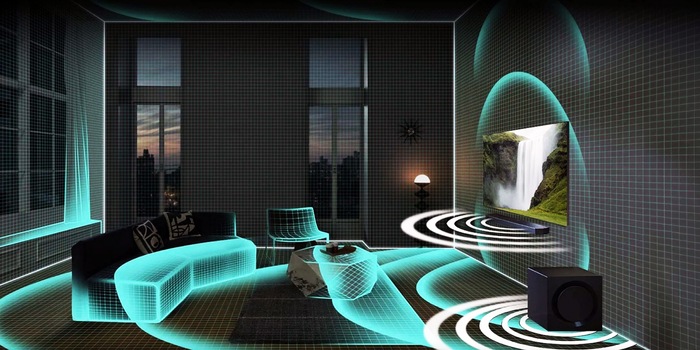
Background information
Samsung’s TV head honcho: «We don’t need Dolby Vision for a good picture»
by Luca Fontana

TV manufacturer Samsung dispensed with Dolby Vision a long time ago. Now Dolby Atmos is also set to be replaced by IAMF, a new 3D audio format developed with help from Google. But how likely is this?
It’s not the world’s first 3D audio format. But when Samsung and Google join forces, you almost have to sit up and take notice. They’ve developed «Immersive Audio Model and Formats», IAMF for short. According to the industry giants, it’s intended to change the way we reproduce and perceive surround sound at home in the future.
Not that there aren’t already enough 3D audio formats. However, the best known and most common format is undoubtedly Dolby Atmos, closely followed by DTS:X. If you own Sony devices, you should also be familiar with 360 Spatial Audio. Maybe even Auro 3D. Now, Samsung and Google’s IAMF are joining the fray.
In principle, all 3D formats aim for the same thing: perfect surround sound. In other words, when a TIE fighter flies head-on towards the camera in Star Wars, shooting past it in a breakneck manoeuvre, the sound in your living room should make it seem as if a spaceship has just whizzed past your shoulder and is now zooming away behind you.
Samsung and Google’s IAMF is taking the same approach, but wants to do a few things better than its competitors. Samsung only recently communicated this in a press release.
IAMF will be open source and won’t cost interested partners any licence fees. No surprise there. This is a well-known Samsung tactic, known for refusing to implement the widespread premium HDR format Dolby Vision on its televisions – probably precisely because of the licence fees involved. This isn’t officially confirmed. The South Koreans insist that they simply don’t need it to create a good image.
Furthermore, IAMF is said to be the first open source audio format supporting horizontal sound playback – i.e. sound from above. Dolby Atmos and DTS:X can do it too, you just need to pay a licence fee.
However, the announcement that IAMF can analyse scenes independently using AI and deep learning technologies sounds much more exciting. The aim is to determine which audio aspects are important and should be emphasised – without manual intervention when mixing the sound. «In TV and film, there are certain scenes where the soundtrack or background music is the main focus,» a Samsung spokesperson said in the media release. «IAMF will balance the sound in these instances. Similarly, the technology will fine-tune audio when there is character dialogue to allow the listener to focus on the conversation.»
This might be a good thing, unless AI intervenes too much. This could compromise the original intention of the director or sound engineer. Purists the world over cower in fear. However, anyone who has trouble hearing dialogue in a cacophony of explosions during action scenes – especially older viewers or people with hearing impairments – likely won’t care.
In addition, listeners should be able to mix the sound themselves and freely adjust it to their preferences if they so wish. In my opinion, this speaks against the deep learning idea of the technology. On the other hand, it gives us the flexibility to adapt the sound to each individual ear.
We’re likely to get our first taste of IAMF at the CES technology trade fair in Las Vegas in January 2024. Until then, it’s hard to say whether IAMF has what it takes to drive out Dolby Atmos or DTS:X.
Judging by how Samsung’s in-house HDR format HDR10+ was received, the chances are slim. HDR10+ is a format that, just like Dolby Vision, relies on dynamic metadata and – you guessed it – is available without licence fees. And yet, HDR10+ content is still in short supply. You can find some on Prime Video, but most other major streaming services or UHD Blu-ray distributors consistently use Dolby Vision and Dolby Atmos. In addition, not all manufacturers support HDR10+. LG and Sony televisions, for example.
Convincing consumers that IAMF – together with HDR10+ – is better than Dolby or DTS formats is likely to be difficult. Even with an industry giant like Google at Samsung’s side, whose role was primarily to ensure the best possible compatibility with audio devices.
I write about technology as if it were cinema, and about films as if they were real life. Between bits and blockbusters, I’m after stories that move people, not just generate clicks. And yes – sometimes I listen to film scores louder than I probably should.
Interesting facts about products, behind-the-scenes looks at manufacturers and deep-dives on interesting people.
Show all